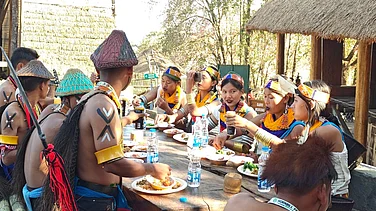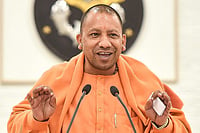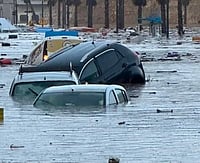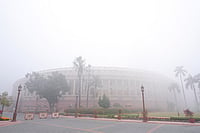A fresh stream of hope floats in the dingy bylanes of Ayodhya, as public opinion here looks seriously at a solution for the masjid-mandir tangle. The people in this holy town have now got together to resolve the Ramjanmabhoomi-Babri Masjid conflict on their own. Yes, on their own. This is the great new dream of Ayodhya.
The reasons are not far away. Large sections here believe excavations at the disputed site don't guarantee a solution. That's why the new 'plan'. It's time to heal old wounds.
Led by Shiwendra Sahi, a descendant of the raja of the erstwhile princely state of Deara (which included parts of Ayodhya), several local Hindu and Muslim leaders are busy these days actively putting together a coalition. Sahi and his associates are resurrecting a detailed plan worked out by a peace committee set up by the residents of Faizabad and Ayodhya in 1989. The committee had a large representation of Hindu opinion leaders—Shanti Swarup Rana, Falahari Baba, Dhiren Jafa—along with those from the other side like Maulana Basir, Captain Afzal and a host of local maulvis. The convenor was Sheetla Singh, editor of Hindi daily Jan Morcha, and a widely respected figure in the region.
The committee agreed to a plan envisaging participation of both sides, the Hindus and Muslims. So what was this magical experiment with truth? The mahants could go ahead with the construction of a temple at the site where shilanyas had been done in 1989, east of the makeshift Ram lalla temple. A wall would separate the temple from a place of worship for the Muslims, adjacent to the site where the mosque once stood. A library and a museum were to be developed around these two structures to document symbols and texts of the composite culture and events that led to the formation of this unique architecture. Unfortunately, the plan had to be shelved then.
Sahi, on his part, has approached the issue in as many ways as possible. He moved the Supreme Court appealing to be heard as the "original title-holder" in the title suit at the Allahabad High Court. He's getting powerful Muslim and Hindu leaders—even those on opposite ends of this bitter dispute—together. There are also people like Yunus Siddiqui, district president of the All India Babri Masjid Action Committee, and Mahant Gyan Dass, president of the powerful Sankat Mochan Sena who welcomed the efforts to sort out the dispute.
Says Siddiqui: "There was a meeting of the Muslim priests with the Hindus way back in 1990 when our side said you can start temple construction where shilanyas had been done. But that didn't work out, they wanted to keep the issue alive."
Sahi compares the scenario to "a war". "The issue has been made extremely complicated. But the genuine sants, maulvis and the peace-loving people of Ayodhya will not allow this to go on. We will formalise the committee of sadhus and Muslim priests by March end. Subsequently, we will also carry out a 'Ram raksha yatra' to stop the political parties (read the VHP and BJP) from exploiting religious sentiments for political gains."
Argues Siddiqui: "A solution is possible if there is a strong national will. The Allahabad High Court has been hearing the title suit and a decision either way can resolve the issue. But the issue is being fought not just legally but politically as well. The VHP has been exploiting the religious sentiments of the Hindus since 1983. Where is the temple?"
Khaliq Ahmad Khan, lawyer and convenor of the Faizabad-based Helal Committee, says the decision to acquire land in Ayodhya soon after December 6, 1992, was also to develop the area in a manner that represents the composite culture of Ayodhya. He believes the objectives of the Land Acquisition of Certain Area at Ayodhya Act, 1993, are similar to the ones described by the peace committee—to maintain communal harmony, set up a complex where a Ram temple, a mosque, amenities for devotees, a library and a museum can be built.Siddiqui adds that it's crucial to mobilise public opinion now. Or else, the peace move could once again be scuttled as in 1989.
Outside the VHP's xenophobic rhetoric, several committed people are quietly working. Even the sants are marching in. Sahi's group will have members of the powerful Nirvani, Nirmohi and Digambar akharas in Ayodhya along with Naga sadhus and Muslim representatives. Efforts are now on at a "war footing". This "conflict", he asserts, will have to be resolved at various levels. Keeping the politicians out will be tough but even so getting the sadhus and the mullahs together will be a major breakthrough.
Mahant Gyan Dass, president, Sankatmochan Sena, is a vocal proponent of the 'keep the politicians out from Ayodhya' campaign. He believes the "artificial conflict" can be resolved. "The politicians want to make things more complicated. This entire exercise of digging up the area around the structure is geared to gain political mileage. Everyone involved in this charade is a devil," he says.
His views find resonance across most religious akharas in Ayodhya. Baba Kaushal Kishore Das Falahari, a prominent member of the Sadhu Samaj here, says: "I don't understand what the Hindus will gain by constructing a temple. And how are we to lose if we don't build one? The whole affair makes me want to scream with helplessness. It's like watching Draupadi being disrobed...how can we stop this destruction?"
Siddiqui feels "the BJP internationalised this issue when they demolished the mosque. Their effort is not to find a solution but to keep the issue simmering. The parliamentary elections are around the corner. That is why this new drama is being enacted. If the peace committee revives its efforts, we will welcome it with open arms."
Sheetla Singh feels the 1989 peace move disintegrated because it was a little too honest for anyone's comfort. "The VHP realised that no political manipulation will be allowed. So they saw to it that it fizzled out. If the government allows local leaders—the mahants and Muslims—to sort out this mess, we can work it out peacefully. But that's precisely what they don't want."
Singh says the peace committee had been able to retain a degree of sanity in the holy town. Earlier, there were even threshold moments when it seemed the impossible could be achieved. He still remembers the day when he got the most passionate Muslim claimant to the disputed land, Hashim Ansari, and his equally belligerent counterpart, Ramachandra Paramhans of the VHP, together for a cup of tea. "We took Paramhans to Ansari's house. It was a sombre moment. But things have become bitter over the years," says Singh. The image of Paramhans sitting with Ansari in his modest drawing room was displayed prominently in the local dailies. For the people of Ayodhya, it was a great moment of reconciliation and hope.
Hashim still talks wistfully of that encounter. So do a lot of people in Ayodhya and Faizabad who've become tired of the politicisation of an issue which they would rather sit down and sort out by themselves. Indeed, it's high time that Ayodhya be given that chance. So that peace can once again return to the banks of river Saryu.
Dream Theme
An '89 peace plan with local support may be the answer ? Updates

Dream Theme
Dream Theme
Published At:
- Previous Story
 Hornbill Festival: A Modern Spectacle For Wider Entertainment, Drifting From Its Origins
Hornbill Festival: A Modern Spectacle For Wider Entertainment, Drifting From Its Origins - Next Story
MOST POPULAR
WATCH
MORE FROM THE AUTHOR
PHOTOS
×





















